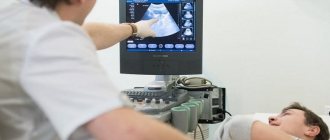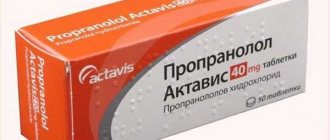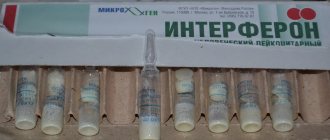Indications for use of the drug Interferon beta
Acute, recurrent and chronic viral infections, including genital herpes, herpetic lesions of the lips, herpes zoster (localized or disseminated); viral papillomas, flat and genital warts; chronic active hepatitis B in adults with serological markers of viral replication; chronic active hepatitis C, a short-term decrease in viral activity in adults with chronic active hepatitis C with high transaminase levels without liver dysfunction; epithelial neoplasms of the cervix; pleural effusion due to neoplastic processes; hairy cell leukemia; induction of steroid receptors in patients with breast carcinoma or endometrial carcinoma who are subsequently prescribed hormonal therapy.
Contraindications
β1- and β2-adrenolytics have similar contraindications for use. Drugs are not prescribed for:
- atrioventricular block;
- bradycardia;
- orthostatic hypotension;
- sinoatrial block;
- left ventricular failure;
- terminal cirrhosis of the liver;
- obstructive pulmonary disease;
- decompensated kidney failure;
- chronic pathologies of the bronchi;
- vasospastic angina;
- acute myocardial failure.
Selective adrenergic blockers are not taken in case of peripheral circulation disorders, pregnancy and lactation.
Use of the drug Interferon beta
For disseminated or insensitive to local therapy, herpetic lesions are used daily intramuscularly at a dose of 2,000,000 IU for 10 days (in combination with use as an ointment). For flat and genital condylomas, especially in severe cases of the disease or forms of condylomatosis that are difficult to treat, it is injected into the affected area or surrounding tissues or intramuscularly. IM administration is more preferable in cases of multiple localization of the lesion and/or when the introduction of interferon directly into the affected area or surrounding tissue is difficult. For administration to the affected area or adjacent tissues, it is recommended to administer a dose of 1,000,000–3,000,000 IU/day for 5 days; if necessary, the course of treatment is repeated after 1–2 weeks. For intramuscular injections - 2,000,000 IU/day for 10 days. The use of interferon beta can be combined with other types of therapy: cauterization and cryotherapy, the use of synthetic antiviral agents. For chronic viral hepatitis B, it is recommended to administer a dose of 5,000,000 IU/m2 of body surface by intramuscular injection 3 times a week for 6 months. If 1 month after the start of therapy the HBeAg content does not decrease, the dose can be increased. In the future, the dose can be adjusted in accordance with the patient’s tolerability of this therapeutic regimen. If there is no improvement within 3–4 months, the advisability of continuing therapy should be considered. For viral hepatitis C, the recommended dose is 6,000,000 IU/m2 of body surface, administered intramuscularly 3 times a week for 2 months, if necessary, treatment is continued for up to 3–6 months. An indicator of the effectiveness of the therapy is the normalization of transaminase levels within 16 weeks. If there is no improvement within this period, treatment is stopped. Experience with recurrent therapy is limited and its effectiveness cannot currently be assessed. For cervical cancer, it is recommended to administer into the affected area a dose of 3,000,000 IU/day for 5 days; then - at the same dose every other day for 2 weeks. In the presence of pleural effusion due to tumors, 5,000,000 IU is administered intrapleurally, after 7–15 days another 10,000,000 IU is administered in an isotonic solution of sodium chloride. If a relapse occurs 15 days after the second injection, another 20,000,000 IU of interferon beta is administered. For hairy cell leukemia, the inducing dose of interferon beta is 6,000,000 IU/m2 per day for 7 days; carry out 3 courses of treatment with a week interval between them. Maintenance dose: 6,000,000 IU/m2 via slow IV infusion twice a week for 24 weeks. In order to induce steroid receptors in breast carcinoma or endometrial carcinoma, intramuscular injections of 2,000,000–6,000,000 IU are performed every other day for 2 weeks. Administration in this mode can be repeated during hormonal therapy at 4-week intervals.
Side effects of the drug Interferon beta
With parenteral administration of interferon beta, the development of adverse reactions from the cardiovascular and central nervous systems is possible. Possible fever, fatigue, myalgia, occasional headache, nausea, vomiting. In case of long-term treatment, leukopenia, thrombocytopenia, anemia, increased prothrombin time, temporary increase in transaminase activity, tachycardia, anorexia, pain in bones and joints, drowsiness, diarrhea, decreased blood pressure, shortness of breath, alopecia are possible. These side effects are reversible even after long courses of treatment. If there is a significant increase in body temperature (more than 40 ° C) with chills, vomiting and fluctuations in blood pressure, the dose should be reduced or interferon should be discontinued.
Special instructions for the use of the drug Interferon beta
When treated with recombinant interferon alfa, patients with chronic active hepatitis C rarely (in less than 1% of cases) developed thyroid dysfunction. Although treatment with interferon beta has not been associated with such disorders, the possibility of their occurrence should be considered. During treatment, electrolyte balance and hematological parameters should be carefully monitored. When receiving results of counting leukocytes, platelets and hemoglobin levels that are borderline pathological, hematological studies are recommended to be carried out 1–2 times a week. If prothrombin time increases, this parameter must be monitored daily. The therapeutic effectiveness of interferon beta in patients with chronic hepatitis B against the background of HIV infection has not been proven. When using interferon beta in ophthalmology, special attention should be paid to differential diagnosis to exclude damage to the cornea by physicochemical agents or damage of non-viral origin. Excessively high doses of interferon beta may delay regeneration in affected areas of the eye. Parenteral administration of interferon beta simultaneously with cardiotoxic drugs, as well as in patients with cardiopathy, must be carried out under strict medical supervision. Long-term administration of topical drugs may lead to the development of local hypersensitivity reactions. In this case, therapy is stopped and appropriate treatment is carried out to eliminate undesirable consequences. Interferon beta is contraindicated during pregnancy, since its effect on the fetus has not been studied.
Interferon beta-1b
International name of the medicinal substance:
Interferon beta-1b (Interferon beta-1b) The list of drugs containing the active substance Interferon beta-1b is given after the description.
Pharmacological action:
Has antiviral and immunomodulatory activity.
Suppresses viral replication, interacts with specific receptors located on the surface of human cells, reduces binding capacity and expression, inactivates receptors sensitive to interferon gamma, activates the function of T-suppressors, weakens the effect of antibodies to the main components of myelin. Increases the suppressor activity of peripheral blood mononuclear cells. Pharmacokinetics:
Bioavailability - 50% (after subcutaneous administration of 0.5 g). TCmax - 1-8 hours, Cmax - 40 IU/ml. With intravenous administration, clearance is 30 ml/min/kg, T1/2 is 5 hours. During a course of treatment, the pharmacokinetic parameters of the drug do not change significantly.
Indications:
Multiple sclerosis of relapsing course, secondary progressive form of multiple sclerosis.
Contraindications:
Hypersensitivity (including to human albumin), pregnancy, lactation.
Side effects:
Very often - 10% or more;
relatively often - 1-10%; infrequently - 0.001-1%; rarely - 0.001-0.00001%; very rarely - less than 0.0001% From the nervous system and sensory organs: infrequently - muscle hypertonicity, depression; rarely - convulsions, confusion, agitation, emotional lability, suicidal attempts. From the cardiovascular system: infrequently - increased blood pressure; rarely - cardiomyopathy, tachycardia, palpitations. From the endocrine system: rarely - dysfunction of the thyroid gland (hypothyroidism, hyperthyroidism), menstrual irregularities. From the digestive system: infrequently - nausea, vomiting, increased activity of liver transaminases (AST, ALT); rarely - pancreatitis, increased GGT activity, hyperbilirubinemia. From the hematopoietic organs: infrequently - leukopenia, anemia, thrombocytopenia; rarely - lymphadenopathy. Local reactions: very often - pain, hyperemia, local swelling, inflammation; often - skin necrosis. From the respiratory system: rarely - shortness of breath, bronchospasm. From the skin: infrequently - alopecia, urticaria, skin itching, skin rash; rarely - change in skin color, increased sweating. Allergic reactions: rarely - anaphylactic reactions, bronchospasm, urticaria. Other: very often - flu-like syndrome (fever, headache, myalgia, chills, malaise, sweating); uncommon - myalgia; rarely - malaise, chest pain, hypertriglyceridemia. Interaction:
Possible combination with GCS and ACTH during exacerbation of the disease.
Interferons reduce the activity of cytochrome P450 enzymes. Caution should be exercised when prescribed together with drugs, the clearance of which largely depends on the liver cytochrome P450 system (anti-epileptic drugs, antidepressants). Use caution when simultaneous use of any drugs that affect the hematopoietic system. Special instructions:
Long-term treatment (many years), with mandatory medical examinations and monitoring of the peripheral blood picture (number of leukocytes, platelets), blood chemistry, activity of “liver” enzymes in plasma, thyroid function.
If cardiomyopathy develops, treatment is stopped. Necrosis at the injection site can be extensive and spread to the muscle fascia and subcutaneous fat with the formation of scars. In some cases, removal of necrotic areas or, less commonly, skin grafting is necessary. If multiple foci of necrosis appear, treatment should be stopped until they are completely healed (for up to 6 months); if there is one foci and the absence of extensive necrosis, treatment can be continued. In order to reduce the risk of developing necrosis, it is necessary to perform injections under sterile conditions, change the injection site each time, and administer strictly subcutaneously. The presence of neutralizing antibodies has not been shown to significantly influence treatment outcomes (including MRI). The decision to continue or discontinue therapy in such cases should be based on clinical disease activity. The use of cytokines in patients with monoclonal gammopathy has sometimes been associated with increased capillary permeability with symptoms of shock and death. The drug should not be used if the contents are not completely dissolved or the color of the solution has changed. Do not shake the bottle. Use the prepared solution immediately. During the treatment period, care must be taken when driving vehicles and engaging in other potentially hazardous activities that require increased concentration and speed of psychomotor reactions. Preparations containing the active substance Interferon beta-1b:
Human recombinant Interferon beta-1b (rhIFN-beta), Infibeta, Ronbetal
The information provided in this section is intended for medical and pharmaceutical professionals and should not be used for self-medication. The information is provided for informational purposes only and cannot be considered official.
Interferon beta drug interactions
It should not be prescribed simultaneously with steroid drugs, acetylsalicylic acid, indomethacin or other NSAIDs that affect prostaglandin metabolism, since such a combination can lead to a decrease in the biological activity of interferon beta. If it is necessary to use analgesics, preference should be given to drugs such as paracetamol. Interferon beta may reduce the clearance and increase the plasma half-life of theophylline.
List of pharmacies where you can buy Interferon beta:
- Moscow
- Saint Petersburg
To whom and when are adrenergic blockers prescribed?
Selective and non-selective β-adrenolytics are recommended for the symptomatic treatment of many diseases. They have a different spectrum of action, so the indications for their use differ.
Indications for the use of non-selective adrenergic blockers:
- tremor;
- hypertension;
- painful palpitations;
- mitral valve prolapse;
- tense angina;
- cholecystocardiac syndrome;
- high intraocular pressure;
- cardiomyopathy;
- prevention of ventricular arrhythmia;
- preventing the risk of recurrent myocardial infarction.
Selective adrenergic blockers act on the myocardium, with almost no effect on the capillaries. Therefore, heart pathologies are treated with such means:
- heart attack;
- paroxysmal arrhythmia;
- coronary heart disease;
- neurocirculatory dystonia;
- atrial tachycardia;
- atrial fibrillation;
- left valve prolapse.
Beta blockers, which have the properties of α-adrenolytics, are used in combination therapy:
- glaucoma;
- myocardial failure;
- hypertension and hypertensive crisis;
- arrhythmias.
Drugs that affect myocardial contractile activity should not be used for self-medication. Irrational therapy is fraught with increased load on the vascular system and cardiac arrest.






